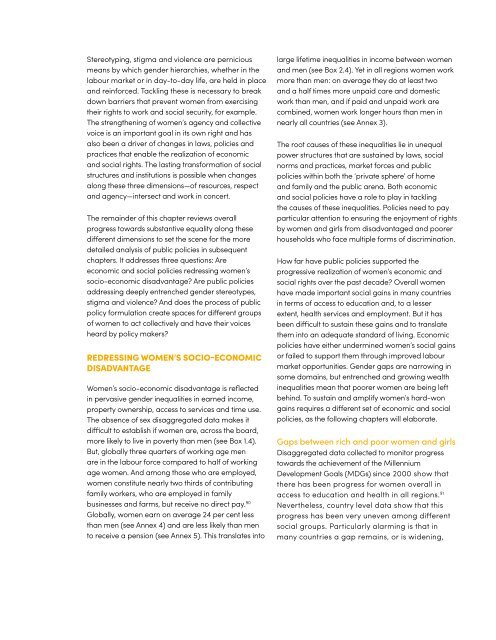1GzuFGC
1GzuFGC
1GzuFGC
Create successful ePaper yourself
Turn your PDF publications into a flip-book with our unique Google optimized e-Paper software.
Stereotyping, stigma and violence are perniciousmeans by which gender hierarchies, whether in thelabour market or in day-to-day life, are held in placeand reinforced. Tackling these is necessary to breakdown barriers that prevent women from exercisingtheir rights to work and social security, for example.The strengthening of women’s agency and collectivevoice is an important goal in its own right and hasalso been a driver of changes in laws, policies andpractices that enable the realization of economicand social rights. The lasting transformation of socialstructures and institutions is possible when changesalong these three dimensions—of resources, respectand agency—intersect and work in concert.The remainder of this chapter reviews overallprogress towards substantive equality along thesedifferent dimensions to set the scene for the moredetailed analysis of public policies in subsequentchapters. It addresses three questions: Areeconomic and social policies redressing women’ssocio-economic disadvantage? Are public policiesaddressing deeply entrenched gender stereotypes,stigma and violence? And does the process of publicpolicy formulation create spaces for different groupsof women to act collectively and have their voicesheard by policy makers?REDRESSING WOMEN’S SOCIO-ECONOMICDISADVANTAGEWomen’s socio-economic disadvantage is reflectedin pervasive gender inequalities in earned income,property ownership, access to services and time use.The absence of sex disaggregated data makes itdifficult to establish if women are, across the board,more likely to live in poverty than men (see Box 1.4).But, globally three quarters of working age menare in the labour force compared to half of workingage women. And among those who are employed,women constitute nearly two thirds of contributingfamily workers, who are employed in familybusinesses and farms, but receive no direct pay. 90Globally, women earn on average 24 per cent lessthan men (see Annex 4) and are less likely than mento receive a pension (see Annex 5). This translates intolarge lifetime inequalities in income between womenand men (see Box 2.4). Yet in all regions women workmore than men: on average they do at least twoand a half times more unpaid care and domesticwork than men, and if paid and unpaid work arecombined, women work longer hours than men innearly all countries (see Annex 3).The root causes of these inequalities lie in unequalpower structures that are sustained by laws, socialnorms and practices, market forces and publicpolicies within both the ‘private sphere’ of homeand family and the public arena. Both economicand social policies have a role to play in tacklingthe causes of these inequalities. Policies need to payparticular attention to ensuring the enjoyment of rightsby women and girls from disadvantaged and poorerhouseholds who face multiple forms of discrimination.How far have public policies supported theprogressive realization of women’s economic andsocial rights over the past decade? Overall womenhave made important social gains in many countriesin terms of access to education and, to a lesserextent, health services and employment. But it hasbeen difficult to sustain these gains and to translatethem into an adequate standard of living. Economicpolicies have either undermined women’s social gainsor failed to support them through improved labourmarket opportunities. Gender gaps are narrowing insome domains, but entrenched and growing wealthinequalities mean that poorer women are being leftbehind. To sustain and amplify women’s hard-wongains requires a different set of economic and socialpolicies, as the following chapters will elaborate.Gaps between rich and poor women and girlsDisaggregated data collected to monitor progresstowards the achievement of the MillenniumDevelopment Goals (MDGs) since 2000 show thatthere has been progress for women overall inaccess to education and health in all regions. 91Nevertheless, country level data show that thisprogress has been very uneven among differentsocial groups. Particularly alarming is that inmany countries a gap remains, or is widening,


